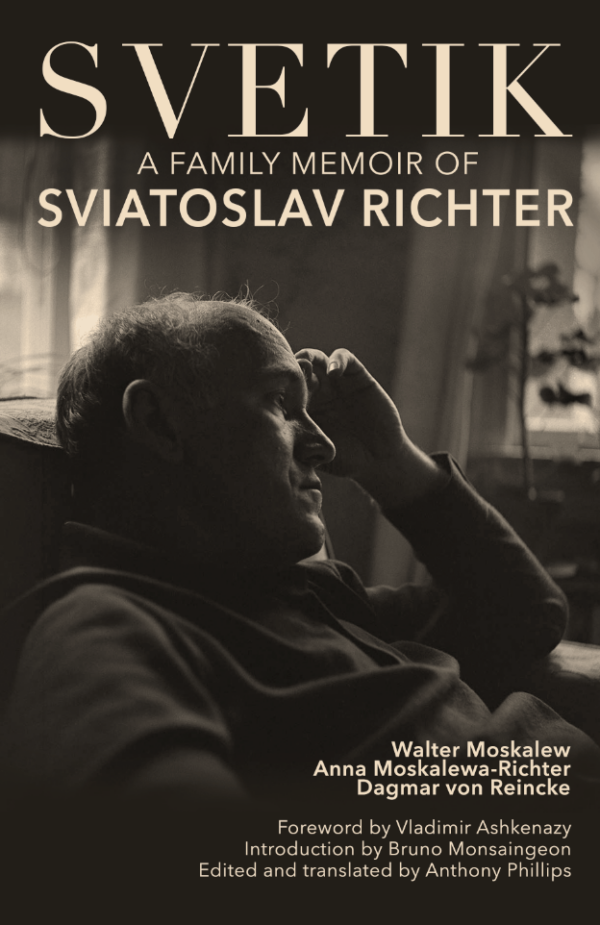SVETIK: A Family Memoir of Sviatoslav Richter
Discovery Club Members save even more!
Login or Join Today
Walter Moskalew, Anna Moskalewa-Richter and Dagmar von Reincke
Foreword by Vladimir Ashkenazy
Introduction by Bruno Monsaingeon
Translated and edited by Anthony Phillips
Extent: 462 pages
Size: 16 x 24 cm
Published: October 2015
Illustrations: c. 30 colour illustrations; c. 250 b/w illustrations
Composition: Foreword by Vladimir Ashkenazy ~ Introduction by Bruno Monsaingeon ~ A Note on the Origins of this Book by Anthony Phillips ~ Acknowledgements ~ Moskalew Family Genealogy ~ Notes on Names, Places and Dates ~ Part I: Three Sisters by Walter Moskalew (Prologue; 1. Zhitomir, Odessa and the War; 2. Schwäbisch Gmünd; 3. Nyuta, Svetik and Meri; 4. More Tours of America; 5. Sorrow and Joy; 6. Reginald and Dora; 7. Holding On to Imagination with Both Hands #) ~ Part II: My Life – The Memoirs of Anna Moskalewa-Richter ~ Part III: Sketches by Tamara Moskalewa/Dagmar von Reincke (1. Lenochka’s Death; 2. A Quite Different Sort of Boy: Introduction; The Dandelion; The Pastrycooks; Wasps; Nyurka; A Rainy Day; The Cinema; Vignettes) ~ Appendices ~ Glossary of Names and Places ~ Index
For well over half a century, since the Soviet regime first allowed Sviatoslav Richter to travel to the west, his name has been synonymous with the very pinnacle of pianistic art. His recorded legacy, extending from 1947 to 1994 – over 80 per cent of it from live performances – is one of the largest and most admired ever assembled by any musician anywhere. Yet this prodigiously gifted artist, whose personality Pierre Boulez characterised as being ‘greater than the possibilities offered to him by the piano and broader than the very concept of complete mastery of the instrument’, underwent no formal musical studies of any kind until at the age of 22 he left the relative obscurity of the Ukraine, where he had been born in 1915, to seek the advice of Russia’s most celebrated piano pedagogue, Heinrich Neuhaus, in Moscow. Neuhaus’ astonished reaction to his first encounter with Richter, and his declaration that ‘to teach one who already knows will only do damage’, have passed into legend.
Richter, a famously reclusive man outside a small circle of trusted companions, resisted speaking or writing about himself. As a result, comparatively little is known about his life before his move to Moscow. This lavishly illustrated book provides unique insights into the childhood and formative years of ‘Svetik’ – ‘Little Light’, as he was always known within the large and unusually creative family circle – in a provincial Ukrainian city during the traumatic years of revolution, civil war, famine and wartime occupation by German and Romanian forces. Walter Moskalew, Richter’s much younger cousin, is guardian of a rich collection of photographs, reminiscences, drawings and letters of family members, notably the memoirs of Richter’s mother Anna and his twenty-year-long correspondence with his beloved Aunt Meri. Walter Moskalew has collaborated with editor and translator Anthony Phillips to produce an indispensable account of the influences that shaped the artistry and world-view of the phenomenon that was Sviatoslav Richter.


Barbara meredith :
This volume is lavishly and beautifully illustrated with photographs and drawings, and is wonderfully easy to read. It draws the reader into the all-important back story of Svetik’s young life, and the influences which contributed to who he was as a person and musician. Separation features large in both his childhood and adult lives, while the stories of reunion and reconciliation in later years shed light on and enhance understanding of Richter’s emergence as an artist in the West. For those who never had the intense pleasure of hearing Richter play live, perhaps this book will lead them to explore his extensive discography. For those who did have this pleasure, as I did on two occasions, their understanding of Richter as a person and the influences of his family over the years, will add a whole new dimension to their appreciation of his artistry. This volume has clearly been a labour of love for the authors and editors, as well as the publishers. It has been long-awaited, but the wait has proved very worthwhile.
R. James Tobin :
What we have here is a carefully preserved grouping of primary sources about the pianist and—especially—his family. It is not a formal biography, but the authors of the Introduction and Foreword tell us that it fills significant gaps in what was known about Sviatoslav Richter.
Richter was born in 1915, thus in the second year of the First World War and only two years before the Russian Revolution. Both events, especially the German invasion of Russia and then the Stalinist regime, were enormously disruptive of the lives of all the individuals featured here. At the very beginning of the war, Richter’s parents were in Vienna on an extended honeymoon, and might well have stayed there, as Richter’s father, Theo, was also a musician; but the Sarajevo assassination immediately rendered the couple enemy aliens, as Austria and Russia were at war. Later the couple separated and then divorced. Richter’s mother remarried, to a man whom many considered a colossal bore, and whom Richter detested. Meanwhile, one may enjoy an exquisite photo, on page 326, of the infant “Svetik,” (as Sviatoslav was invariably called by his family) with his clearly pleased parents. His mother, by the way, although not a classic beauty, was assuredly an extremely lovely and good-looking woman.
The bulk of this volume was written by Richter’s younger cousin Walter Moskalew, on the basis of the times he was in a position to know him, particularly on the occasions of Richter’s North American concert tours, between 1960 and 1970. He reports on the brilliant successes of Richter’s performances but does not memorably dwell on particular works, except for Beethoven’s Diabelli Variations. He also recount’s Richter’s travels to England, Switzerland, Italy, Germany and elsewhere in Europe. Much of Walter’s narrative deals with family members other than Svetik.
Sviatoslav’s mother’s diary also deals with family prior to her son’s birth but includes an account of her and Theo’s courtship. She reports that Sviatoslav began playing the piano when he was five years old, trying out combinations of notes and chords without instruction, until he could read music. Eventually he had some lessons from a student of his father, and became proficient enough to play the organ in church and to play the piano as an accompanist. He even composed some pieces at a very young age. Additionally he was very interested in drama and art. At age sixteen he became a repetiteur for a ballet company, and was good at judging the abilities of the dancers. The prima ballerina appears to have had an erotic interest in him but nothing came of that. He had an ambition to become a conductor, but that was frustrated by others with ambitions of their own. So instead he was sent to the Moscow Conservatoire, where he passed the entrance examination brilliantly and studied with Professor Neuhaus. What followed were years of separation from his mother.
The final narrative account included here is by Svetik’s Aunt Meri, his mother’s sister, to whom he became close for the rest of her life, with correspondence between them even when Meri moved to the United States. They shared an interest in art, among other things. This occasioned some sibling rivalry between the mother and the aunt. But what mostly caused that was the great and lengthy geographical separations of the family members, exacerbated by political realities of the time. Sviatoslav, by the way, was completely uninterested in politics or ideology, which undoubtedly kept him safe from the authorities. Even his letters proved of no interest to the censors. He did have minders on his foreign tours, but he had no interest in defecting to the West.
There are two extraordinary unforgettable anecdotes about Richter as a child I feel compelled to relate as illustrations of the character he showed from a young age. At one point two bullies had him against a wall and were beating him until someone intervened. Asked why he did not fight back, he gave the surprising answer, “I am just not that kind of boy.”
The other story—the cruelty of which was worthy of Dickens– was related by his Aunt Meri, from Svetik’s own account when he was six. One day late in the year he was out playing and found some pebbles, which appealed to him, so he pocketed some. On his way home he passed a house on the back steps of which was sitting a girl his own age. She was very thin and responded to questions about her parents with the fact that she was an orphan. Svetik suggested that they invent a game with his pebbles. What then happened is that a woman came out and yelled at the little girl to come in and take out some slops. The girl came back out with a pail which was so heavy for her underfed frame that she proceeded to spill the contents. When her hasty efforts to pick them up were observed by the woman, she took the girl inside and Svetik heared the girl scream, and sounds of a beating. The girl had told Svetik that she was going to run away, and she did, that evening. When Svetik’s family suggested to the orphanage woman that she have the police look for the girl, she declined the suggestion, presumably fearing trouble because of her abusive practices. The story ends with the girl being found and returned to the orphanage the next day. The account has haunted me since.
In spite of the paucity of great detail about Richter’s career, there is much to recommend this book in terms of his times and environment. It contains a vast number of excellent photographs, mostly taken over the years by Cousin Walter. Physically, the book is handsomely produced, and distributed by Boydell Press, all the books from which are printed on heavy stock white paper.
Copyright © 2016 by R. James Tobin
Victor Eskenasy :
“A recent book published by the British music publisher Toccata Press, led by musicologist Martin Anderson, comes to explain in detail the childhood and adolescence of Sviatoslav Richter from Ukraine who lived in Zhytomyr and Odessa before moving to Moscow on the eve of the second World War. … [It is a] family story about the pianist and his close relatives with about 400 original photographs as well as drawings and paintings by Meri, her brother Koli and his Svetik / Sviatoslav Richter himself. … A history that is worth reading …” –Europa Libera, March 2016
James Harrington :
‘This is not a traditional biography… It is a feast for the eyes, with 250 black-and-white pictures and drawings (a number by Richter himself), as well as 30 color pictures. … And it reads well. It is far more than a reference and should on the shelves of a large number of Richter admirers. Nowhere is this kind of information available, especially about his young life. … This is truly an indispensable book for all who want to know more about Richter, the man and the musician, and how he came to be who he was.’ —American Record Guide, November/December 2016